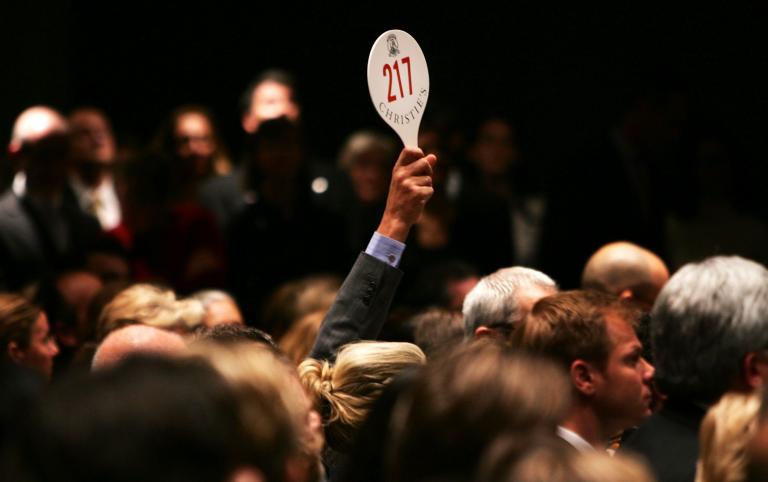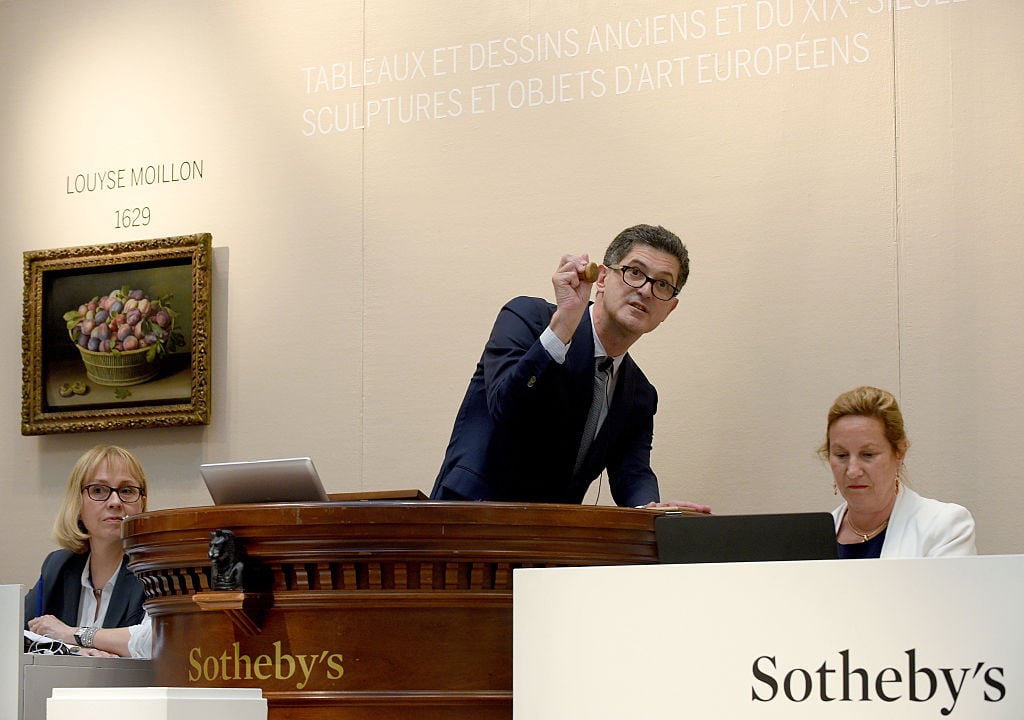Auctions
Artiquette: 11 Things Not to Do at an Art Auction
Keep your hands in your lap or prepare to bid.

Keep your hands in your lap or prepare to bid.

Sarah Cascone

Artiquette is a series that explores etiquette in the art world.
You may not have the big bucks, but that doesn’t mean you can’t dip your toes into the world of collecting. For those just starting out, the auction house can be an extremely intimidating place, and for good reason—one ill-timed yawn, and you could have committed yourself to bidding millions of dollars! If you’re inspired by the current London auctions but aren’t sure how to handle yourself, artnet News has you covered with our best advice for how to navigate the auction circuit and maybe even pick up a painting or two without embarrassing yourself or maxing out your credit card.
1. Don’t raise your hands in the air if you’re not bidding.
It may seem like a movie cliché, but ill-timed hand gestures are a real auction problem. “My absolute pet peeve is when people wave at a friend,” Mark Poltimore deputy chairman of Sotheby’s Europe, told artnet News. “You really do think that they’re bidding on something!” It’s so annoying that auctioneers have been known to out the errant waver by asking if they’re bidding even if they realize that’s not the case.

Auctioner Simon de Pury attends the Gala dinner as part of the 2015 amfAR Hong Kong gala at Shaw Studios on March 14, 2015 in Hong Kong. Courtesy of Jerome Favre/Getty Images.
2. Don’t eat during the auction.
Auctions can be long, so come prepared—but not with snacks. Poltimore also told us that he hates “when people bring in a picnic, taking in all sorts of snacks for the duration of the auction.” Make time to grab something to eat prior to arrival, so you don’t have to bid on an empty stomach.
3. Don’t bid on the wrong lot.
With so much going on, it can be easier than you might think to get confused. People mistakenly placing bids on lots they aren’t interested in is another one of Poltimore’s least favorite auction behaviors.

Sotheby’s auctioneer Henry Wyndham at the auctioneer’s London salesroom in February 2016. Courtesy of Tristan Fewings/Getty Images.
4. This is not the time to get some Zs.
Yes, you can be in for a long night at the auctions, but keep your eyes open. It’s super rude to doze off, and the auctioneer will definitely notice if you fall asleep (which Poltimore assured us “has happened!”).
5. Don’t bid just to drive up the price.
Some dealers and collectors are notorious for placing a single, large bid during the proceedings for a lot, and then withdrawing from the action completely. Yes, this can help maintain a healthy market for artists in your stable or collection without any further financial commitment on your part, but it’s just bad form.
6. Don’t be afraid to follow up after the sale.
When lots fail to find a buyer, post-auction sales can be a collector-on-a-budget’s best friend! If you sat in on the sale and know where the bidding ended, you’ll have a sense of where to place your offer.

The 2014 Circle Auction. Courtesy of Circle Art Agency.
7. Don’t get in over your head with secret signals.
If you want to preserve your anonymity as a buyer, a secret bidding system can be a valuable tool. In artnet News’s round up of auction nightmares, however, one specialist recalled an instance where the price had exceeded an absentminded bidder’s means, but he adjusted his glasses anyway, inadvertently signaling his desire to stay in the fight. Horrified, the bidder had to out himself to get the specialist to stop placing another bid.
8. Don’t forget to take it home.
If the winning bid is yours, you only have a limited time to pick up your new purchase. If you wait too long, you’ll be slammed with some hefty storage fees. Of course, you won’t be the only one: A former Christie’s employee told artnet News that the auction house was still storing works that had been sold in the 1980s.
9. Come prepared.
The last thing you want to do is miss out on a great lot because you can’t figure out the phone lines on time, or because your line of credit isn’t in order. Lord knows we can’t all be Liu Yiqian, who notoriously puts his big-ticket purchases, including his record-setting $170.4 million Amedeo Modigliani nude, on his American Express card to boost his rewards points.

Auctioneer Pierre Mothes gestures during the Tableaux, Sculptures et Dessins Anciens et du XIXe siecle auction sales at Sotheby’s on June 16, 2016 in Paris, France. Courtesy of Antoine Antoniol/Getty Images for Sotheby’s.
10. Don’t place too much faith in the catalogue.
A few years ago, writer Alice Gregory shared an amusing account of the production of Sotheby’s auction catalogues, revealing the over-the-top hyperbole being used to market works hitting the auction block. “I described impasto—paint thickly applied to a canvas, often with a palette knife—almost pornographically and joked with friends on Gchat that I was being paid to write pulp,” Gregory recalled in n+1.
11. Be prepared to pay.
China’s art market has exploded in recent years, but the region was for a time plagued by buyers who weren’t actually paying up after placing the winning bid on multi-million dollar works of art. Sometimes, as in 2009 when an adviser to China’s National Treasures Fund refused to pay after winning a of a pair of Zodiac heads looted from the Summer Palace during the Second Opium War, this was politically-motivated. Regardless, as a general rule, it’s a very, very bad idea to default on a sale.